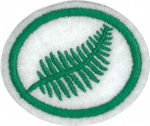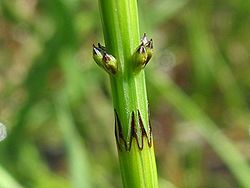Especialidades JA/Helechos/Respuestas
From Pathfinder Wiki
| Helechos | ||
|---|---|---|
| Asociación General
|
Destreza: 2 Año de introducción: 1944 |
|
Requisitos
|
La especialidad de Helechos es un componente de la Maestría Naturaleza. |
| Conexión Logros para la Investidura: Esta especialidad está relacionada con los requisitos de Logros para la Investidura para EXPLORADOR DE CAMPO Y BOSQUE Estudio de la naturaleza que requiere (como una de dos opciones) completar el requisito #6 de esta especialidad. Esta especialidad es una elección popular para la especialidad de la categoría de Estudio de la naturaleza de nivel de destreza 2 o 3 requerido para los EXPLORADORES DE CAMPO Y BOSQUE. |
1
¿Cómo son los helechos diferentes de plantas con flores o los árboles?
2
¿Dónde está la verdadera raíz de un helecho? ¿Qué parte crece por encima del suelo? ¿Cuál es el entorno más favorable en el que los helechos crecen?
3
¿Cómo se reproducen los helechos? Localizar y describir tres tipos de soros (de tres tipos de helechos).
4
¿Cómo viajan las esporas de la planta a una nueva ubicación? ¿Cuánto tiempo tarda una espora en desarrollar una planta madura? Observar de helechos vivos o imágenes cómo un helecho joven es diferente de un helecho adulto.
5
Conocer los usos medicinales de tres helechos.
6
Dibujar o fotografiar 10 tipos de helechos e identificarlos correctamente.
7
Además de los helechos comunes hay plantas conocidos como musgos y colas de caballos. Ser capaz de reconocer dos tipos de musgos y una cola de caballo. ¿Cómo son similares a los helechos?
Club moss is a term that describes the botanical family Lycopodiaceae (a family is one level up the hierarchy from the genus). Club mosses bear spores on specialized structures at the apex of a shoot; they resemble a tiny battle club, from which the common name derives. They are non-flowering and do not produce seeds.
- Lycopodium clavatum (Ground pine)
- This plant resembles a tiny pine tree. It grows in forests and sends runners underground form whence other plants spring.
- Lycopodium serratum (Toothed clubmoss)
- This plant is similar in appearance to L. clavatum. It prefers sandy to loamy soils in dappled or deep shade. The water-repellant spores can be used as a lubricant to keep things from sticking together.
- Lycopodium squarrosum (Tassle fern)
- These plants are also not true ferns. They are also similar to L. clavatum, but they have "branches" which hang from above somewhat like a weeping willow.
Horsetails
Horsetails, like club mosses and ferns bear spores rather than seeds. Horetails are in the order Equisetales which consists of a single family called Equisetaceae. There are 15 species in this order.
- Equisetum arvense (Field Horsetail)
- Equisetum arvense is a rather bushy perennial with a rhizomatous stem formation native to the northern hemisphere. These horsetails may have sterile or fertile stems. Sterile stems start to grow after the fertile stems have wilted. The sterile stems tend to be much taller and bushier, with the jointed segments being around one inch long with a diameter of about 1/20th of an inch. These segments contain one set of whorled, slender, erect branches each. Some stems can have as many as 20 segments and be as tall as 2-24 inches. The fertile stems tend to be half as tall as the sterile stems and also tend to be more succulent.
- Equisetum palustre (Marsh Horsetail)
- E. palustre is a perennial horsetail, growing between 10 to 50 centimeters (4" to 20"), in rare cases up to 1 meter (3'). Its fertile shoots, which carry ears, are evergreen and shaped like the sterile shoots. The rough, furrowed stem is 1 to 3 mm in diameter with usually 8 to 10 ribs, in rare cases 4 to 12. It contains whorled branches. The tight-fitting sheaths end in 4 to 12 teeth. The lower sheaths are dark brown and much shorter than the sheaths of the main shoot. The central and vallecular are about the same size, but the carinal channels are much smaller. The central channels measure about one sixth of the diameter of the stem.
Referencias
Categories:
- Categoría: Tiene imagen de insignia
- Adventist Youth Honors Answer Book/Honors/es
- Adventist Youth Honors Answer Book/es
- Adventist Youth Honors Answer Book/Skill Level 2/es
- Categoría: Libro de respuestas de especialidades JA/Especialidades introducidas en 1944
- Adventist Youth Honors Answer Book/General Conference/es
- Adventist Youth Honors Answer Book/Nature/es
- Adventist Youth Honors Answer Book/Nature/Primary/es
- Adventist Youth Honors Answer Book/Stage 0/es
- Adventist Youth Honors Answer Book/Naturalist Master Award/Flora/es
- Adventist Youth Honors Answer Book/IAConnection/es




